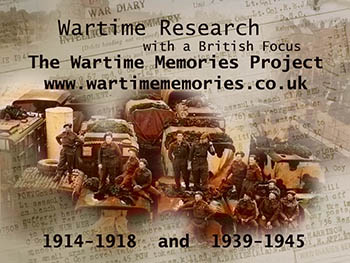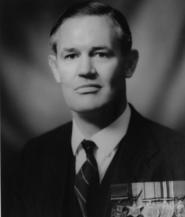Capt. Richard Wallace Annand. VC. Army, 2nd Btn. Durham Light Infantry.
Richard Annand was the first soldier of the Second World War to be awarded the Victoria Cross, in Belgium in May 1940.
His obituary was published in the Times in December 2004:-
The Action in which Dick Annand fought on May 15, 1940, was the first to result in the award of the Victoria Cross to a soldier in the Second World War. As a second lieutenant with no previous operational experience he displayed resolution and personal courage of the highest order. When the battle was over, his first thought was to get his wounded batman to safety.
Belgian neutrality in the early months of the war left the British Expeditionary Force and the French Army with an open flank from the northern end of the Maginot Line to the Channel coast. But, forewarned of a German attack through the Low Countries by a Wehrmacht plan which had fallen into Belgian hands and been handed over to the French, the Allied armies were ready to cross the frontier and occupy a defensive line along the River Dyle, east of Brussels, as soon as Belgian neutrality was breached. Germany launched her attack on May 10, 1940.
Annand was a platoon commander with 2nd Battalion The Durham Light Infantry in the 2nd Division sent to man positions on the Dyle, near the village of La Tombe. The ground on the west bank could hardly have been less suitable; trees and undergrowth made observation of the approaches to the opposite bank difficult and, to the rear, open ground rose steeply to the village. Annand was with D Company covering the road bridge over the Dyle, across which another company of the Durhams had been forced to withdraw before the advancing German Army on the afternoon of May 14, when the bridge was blown.
At 11.00 the next day the enemy launched a violent attack to cover the move of a bridging party into the sunken riverbed. Annand led a group of men from his platoon in a counterattack and, when their small-arms ammunition was exhausted, went forward alone to throw grenades from the edge of the ruined bridge on to the enemy bridging party working below, inflicting some 20 casualties. The enemy was thus prevented from crossing the river in continued fighting, but the situation remained grave, and the company commander had been badly wounded. During the evening of the same day, the enemy launched another attack under cover of intense mortar and machinegun fire. Annand again went forward armed with all the grenades he could carry and attacked the German troops attempting to repair the bridge.
Reporting on the action afterwards, the company sergeant-major said: “They came with a vengeance and were socked with a vengeance. They seemed determined to get that bridge but Jerry could not move old D Company. For two hours it was hell let loose, then they gave up and withdrew.”
But elsewhere the Allied line had broken and at 23.00 the Durhams’ commanding officer gave the order to withdraw as part of the general move back to the line of the River Scheldt. As Annand led the survivors of his platoon away from the bridge in the early hours of May 16, he discovered that his batman, Private Joseph Hunter, from Sunderland, had been wounded in the head and legs and was unable to walk.
Despite his own wounds sustained in the day’s fighting, he found a wheelbarrow, lifted Hunter into it and wheeled him to the rear until their way was barred by a fallen tree. Leaving Hunter in an empty trench he set out to find help but collapsed from exhaustion and loss of blood shortly after finding his company HQ position abandoned.
Hunter was captured by the advancing Germans and sent to a Dutch hospital, but he died of his wounds a month later. The award of the Victoria Cross to Second Lieutenant Annand was gazetted on August 23, 1940. This followed the announcement of the same award to another officer and a Guardsman, but for actions later in the withdrawal of the BEF to Dunkirk.
Richard “Dickie” Wallace Annand was born in South Shields in 1914, the son of Lieutenant-Commander Wallace Moir Annand, who was killed with the Collingwood Battalion of the Royal Naval Division at Gallipoli in June 1915. He was educated at Pocklington School in the East Riding of Yorkshire. He joined the National Provincial Bank in 1933 and became a midshipman in the Tyne Division of the RNVR in the same year.
He applied for a commission in the Royal Navy but was told he was over the age limit for application, so he joined the Army. After a period with the Supplementary Reserve he joined the 2nd Durham Light Infantry.
Although he recovered from wounds received at La Tombe, he was severely deafened in the action and was never again fit for active service. He was invalided out of the army in 1948 and thereafter devoted his life to helping the disabled, taking particular interest in the welfare of the deaf.
He was personnel officer of the Finchdale Abbey Training Centre for the Disabled near Durham until his retirement at the age of 65. The Borough of South Shields had made him an honorary freeman in 1940, and he was appointed a Deputy Lieutenant for Co Durham in 1956. He was president of the Durham branch of the Light Infantry Club until 1998.
He married Shirley Sefton Brittain Osborne in November 1940 and had cause to rescue her from drowning almost 40 years later, in 1979. The couple had attended dinner aboard the frigate HMS Bacchante anchored in the Tyne as guests of her captain. Turning from the foot of the gang plank on leaving to admire the ship, Mrs Annand fell off the quayside into the river. Without hesitation, Captain Annand plunged in and supported her until both were hauled to safety by the ship’s crew. Neither was much the worse for the incident, although Mrs Annand said her fur coat would never be quite the same.
His wife survives him. There were no children. His death leaves only 13 surviving VC holders.






